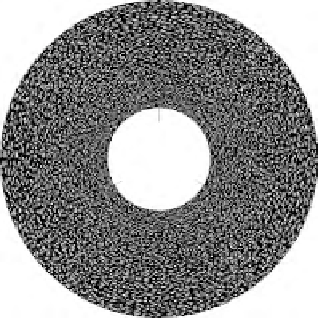Cryptography Reference
In-Depth Information
to align with. Basically, the usage of the circle or cylinder shares increases the
complexity in decoding the secrets. In practical applications, the dealer might
add additional information in the circle shares, such as some supplementary
points, lines, or markers, to ease the superimposition (decoding process) for
the participants. Figure 3.24 shows one possible arrangement in the case of
sharing three secrets as in Experiment 1. Note that circle share A has three
markers (see Figure 3.24(a)), while B has only one (see Figure 3.24(b)) based
upon which A, A
120
, and A
240
can be superimposed with B easily. Or,
the dealer can deliberately organize such information as private key(s) such
that only the legal receivers are informed how to obtain the key(s). The same
reasoning could be applied if the cylinder shares are adopted.
(a)
(b)
FIGURE 3.24
Shares (based upon Experiment 1) with supplementary lines to ease the align-
ments: (a) A with three markers, (b) B with one marker.
Generally speaking, the use of circle or cylinder shares to convey several
secrets discloses some new issues that have not yet been considered in tradi-
tional visual cryptography, such as \How many secrets are there?,"\How to
superimpose the shares (where to align with or in what rotation angles)?,"\Is
there any fake secret(s) for diusion?,"and so on. These concerns can be de-
signed as a set of private keys. The consideration and distribution of these
private keys can be further discussed.
Bibliography
[1] G. Ateniese, C. Blundo, A. De Santis, and D.R. Stinson. Visual cryptog-
raphy for general access structures. Inf. Comput., 129:86{106, 1996.











Search WWH ::

Custom Search